The Cambridge History of Japan, Vol. 3: Medieval Japan
Подождите немного. Документ загружается.


THE ECONOMIC LIFE OF THE PEASANTS 329
fifteenth century, there were cases of local temples' collecting from the
cultivators the land rent in cash.
Land as
property
In the early medieval period, peasants did not hold land as private
property in the true sense of the word. The shoen proprietor formally
registered myoden and isshikiden in the land registry, and because this
land was the basis for
nengu
and zokuji, peasants were forbidden to buy
and sell it without permission. This was not the only reason that such
land was not privately owned, however. From the peasant's point of
view, cultivable land was not always a highly valued "possession." The
peasants invested a great deal of labor in opening arable land, and even
if initially compensated, once the proprietor began to exact taxes and
labor service, the property value of such land was indeed low. Cultiva-
tion rights were not in high demand for land burdened with excessive
imposts, particularly in the case of famine or natural disaster.
In villages near Nara and Kyoto, the sale of the peasants' right to
possess arable land began early. This included selling land outright,
using it as collateral for a loan, and, in many cases, becoming a
tenant on the land as a result of debt default. In most areas, however,
even if the peasants left the land because it no longer provided a
sufficient income, there were not the changes in ownership com-
monly seen later. Instead, in the early medieval period, entire fami-
lies would pack up and start wandering as mibiki, or they would
become genin. For this reason, land abandoned and left vacant was
common. It was the task of the shoen official to see that vacant land
was not left fallow for long. To that end, it was necessary to install on
the land, as quickly as possible, another transient cultivator. Under
these circumstances, it is unlikely that such land could have main-
tained much property value.
In the mid to late medieval period in central Japan and other nearby
economically advanced areas there was a great change in the perceived
value of land. A bill of sale dated 1381, found in the document collec-
tion of the Daitokuji, records that a person named Meuko of Settsu
Province sold two tan of land of the Takehisa myo in Guke District for
five kanmon to one Anshu of Naruo.
47
Subsequently, Meuko paid one
koku of rice yearly as a cultivation fee (kajishi) to Anshu, and the
47 Bill of sale dated 1381, intercalary ninth month, for land referred to as Meuko, in Daitokuji
monjo,
vol. 3, in Tokyo daigaku shiryohensanjo, ed., Dai Nihon komonjo iewake, vol. 17
(Tokyo: Tokyo daigaku shuppankai, 1954), pp. 328-9.
Cambridge Histories Online © Cambridge University Press, 2008
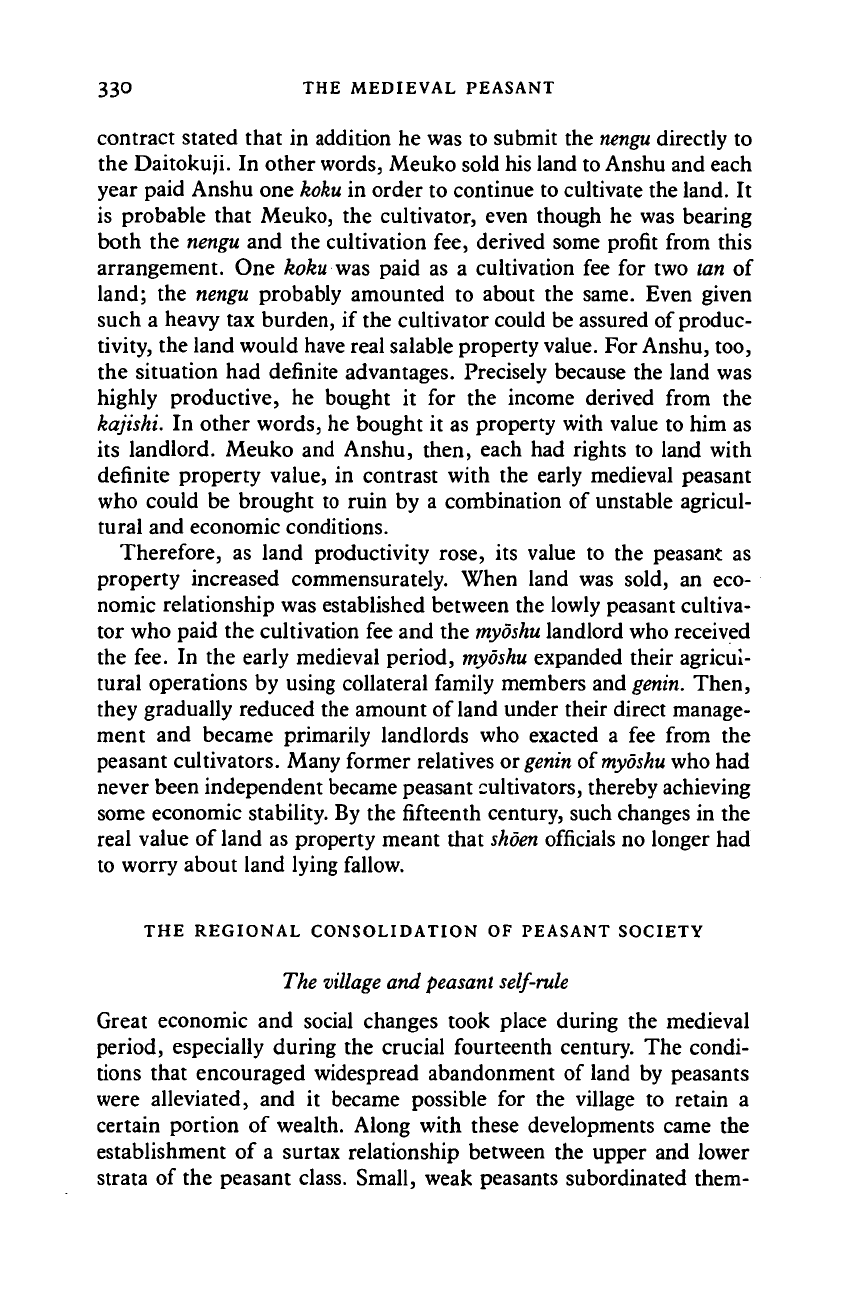
33° THE MEDIEVAL PEASANT
contract stated that in addition he was to submit the
nengu
directly to
the Daitokuji. In other words, Meuko sold his land to Anshu and each
year paid Anshu one
koku
in order to continue to cultivate the land. It
is probable that Meuko, the cultivator, even though he was bearing
both the
nengu
and the cultivation fee, derived some profit from this
arrangement. One koku was paid as a cultivation fee for two tan of
land; the nengu probably amounted to about the same. Even given
such a heavy tax burden, if the cultivator could be assured of produc-
tivity, the land would have real salable property
value.
For Anshu, too,
the situation had definite advantages. Precisely because the land was
highly productive, he bought it for the income derived from the
kajishi. In other words, he bought it as property with value to him as
its landlord. Meuko and Anshu, then, each had rights to land with
definite property value, in contrast with the early medieval peasant
who could be brought to ruin by a combination of unstable agricul-
tural and economic conditions.
Therefore, as land productivity rose, its value to the peasant as
property increased commensurately. When land was sold, an eco-
nomic relationship was established between the lowly peasant cultiva-
tor who paid the cultivation fee and the
myoshu
landlord who received
the fee. In the early medieval period,
myoshu
expanded their agricul-
tural operations by using collateral family members and
genin.
Then,
they gradually reduced the amount of land under their direct manage-
ment and became primarily landlords who exacted a fee from the
peasant cultivators. Many former relatives or
genin
of
myoshu
who had
never been independent became peasant cultivators, thereby achieving
some economic stability. By the fifteenth century, such changes in the
real value of land as property meant that
shoen
officials no longer had
to worry about land lying fallow.
THE REGIONAL CONSOLIDATION OF PEASANT SOCIETY
The village and peasant
self-rule
Great economic and social changes took place during the medieval
period, especially during the crucial fourteenth century. The condi-
tions that encouraged widespread abandonment of land by peasants
were alleviated, and it became possible for the village to retain a
certain portion of wealth. Along with these developments came the
establishment of a surtax relationship between the upper and lower
strata of the peasant class. Small, weak peasants subordinated them-
Cambridge Histories Online © Cambridge University Press, 2008
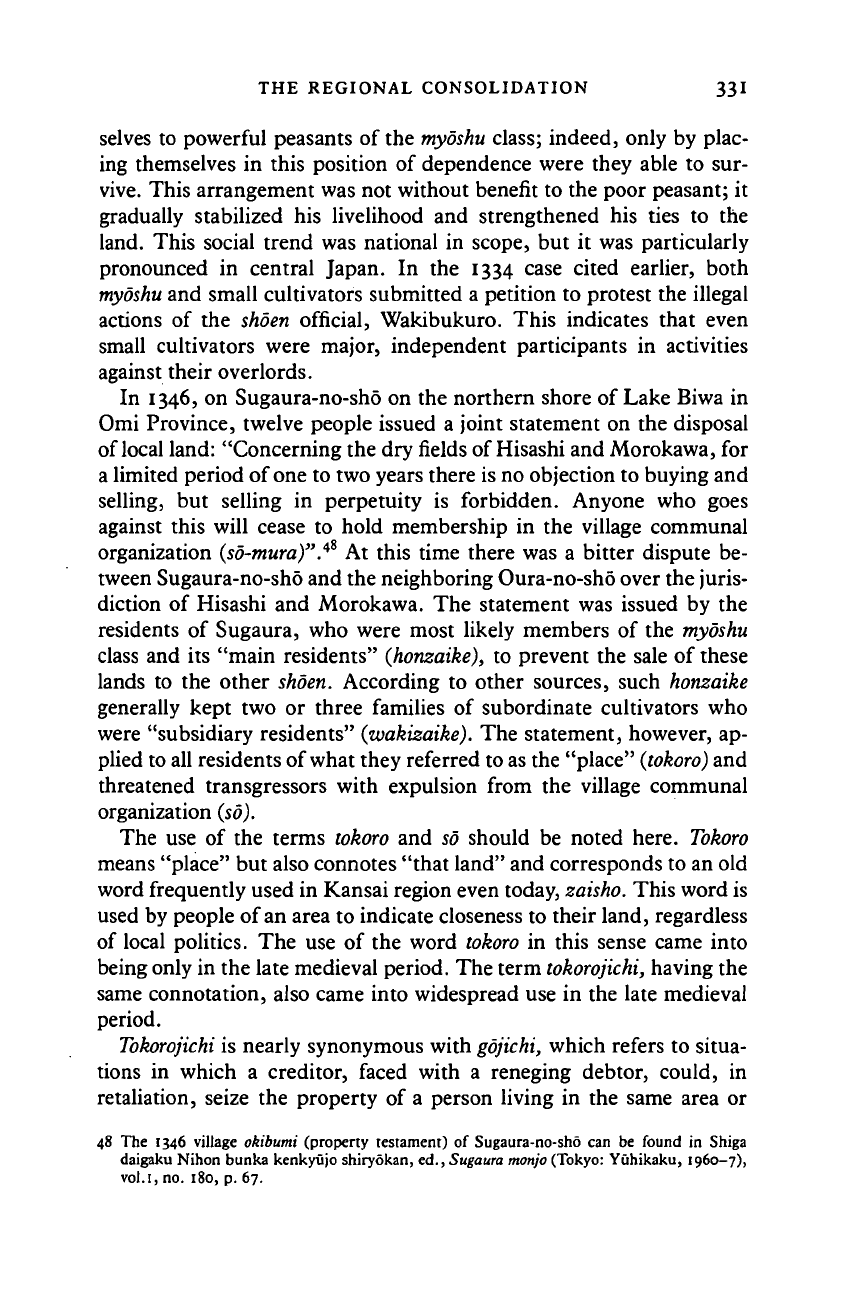
THE REGIONAL CONSOLIDATION 33I
selves to powerful peasants of the myoshu class; indeed, only by plac-
ing themselves in this position of dependence were they able to sur-
vive.
This arrangement was not without benefit to the poor peasant; it
gradually stabilized his livelihood and strengthened his ties to the
land. This social trend was national in scope, but it was particularly
pronounced in central Japan. In the 1334 case cited earlier, both
myoshu
and small cultivators submitted a petition to protest the illegal
actions of the shoen official, Wakibukuro. This indicates that even
small cultivators were major, independent participants in activities
against their overlords.
In 1346, on Sugaura-no-sho on the northern shore of Lake Biwa in
Omi Province, twelve people issued a joint statement on the disposal
of local land: "Concerning the dry fields of Hisashi and Morokawa, for
a limited period of one to two years there is no objection to buying and
selling, but selling in perpetuity is forbidden. Anyone who goes
against this will cease to hold membership in the village communal
organization
(so-mura)"
.
48
At this time there was a bitter dispute be-
tween Sugaura-no-sho and the neighboring Oura-no-sho over the juris-
diction of Hisashi and Morokawa. The statement was issued by the
residents of Sugaura, who were most likely members of the myoshu
class and its "main residents" (honzaike), to prevent the sale of these
lands to the other shoen. According to other sources, such honzaike
generally kept two or three families of subordinate cultivators who
were "subsidiary residents" (wakizaike). The statement, however, ap-
plied to all residents of what they referred to as the "place"
(tokoro)
and
threatened transgressors with expulsion from the village communal
organization (so).
The use of the terms tokoro and so should be noted here. Tokoro
means "place" but also connotes "that land" and corresponds to an old
word frequently used in Kansai region even today, zaisho. This word is
used by people of an area to indicate closeness to their land, regardless
of local politics. The use of the word tokoro in this sense came into
being only in the late medieval period. The term
tokorojichi,
having the
same connotation, also came into widespread use in the late medieval
period.
Tokorojichi
is nearly synonymous with gojichi, which refers to situa-
tions in which a creditor, faced with a reneging debtor, could, in
retaliation, seize the property of a person living in the same area or
48 The 1346 village okibumi (property testament) of Sugaura-no-sho can be found in Shiga
daigaku Nihon bunka kenkyujo shiryokan, ed.,
Sugaura monjo
(Tokyo: Yuhikaku, 1960-7),
vol.i, no. 180, p. 67.
Cambridge Histories Online © Cambridge University Press, 2008
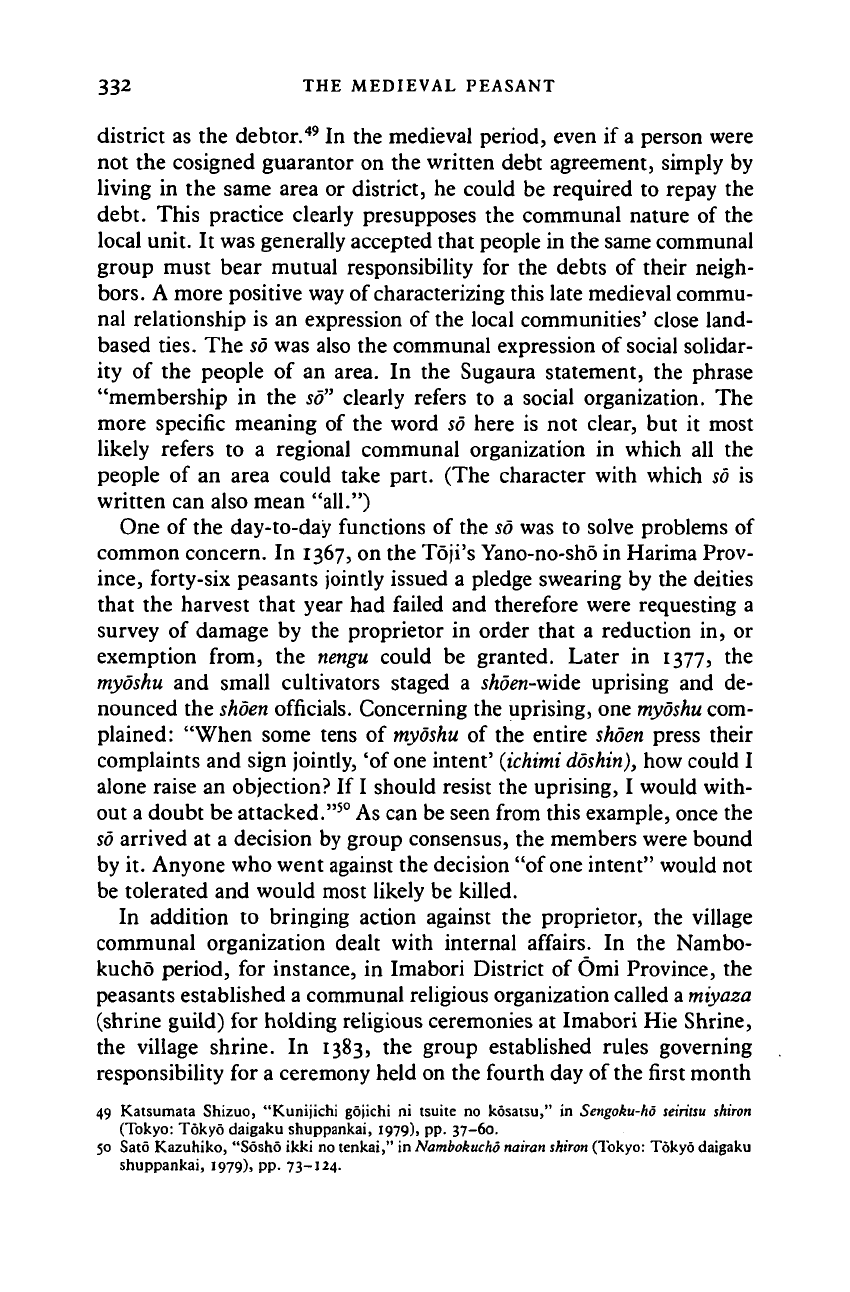
332 THE MEDIEVAL PEASANT
district as the debtor.
49
In the medieval period, even if
a
person were
not the cosigned guarantor on the written debt agreement, simply by
living in the same area or district, he could be required to repay the
debt. This practice clearly presupposes the communal nature of the
local unit. It was generally accepted that people in the same communal
group must bear mutual responsibility for the debts of their neigh-
bors.
A more positive way of characterizing this late medieval commu-
nal relationship is an expression of the local communities' close land-
based ties. The so was also the communal expression of social solidar-
ity of the people of an area. In the Sugaura statement, the phrase
"membership in the so" clearly refers to a social organization. The
more specific meaning of the word so here is not clear, but it most
likely refers to a regional communal organization in which all the
people of an area could take part. (The character with which so is
written can also mean "all.")
One of the day-to-day functions of the
so
was to solve problems of
common concern. In 1367, on the Toji's Yano-no-sho in Harima Prov-
ince,
forty-six peasants jointly issued a pledge swearing by the deities
that the harvest that year had failed and therefore were requesting a
survey of damage by the proprietor in order that a reduction in, or
exemption from, the nengu could be granted. Later in 1377, the
myoshu and small cultivators staged a
shden-wide
uprising and de-
nounced the
shoen
officials. Concerning the uprising, one
myoshu
com-
plained: "When some tens of
myoshu
of the entire
shoen
press their
complaints and sign jointly, 'of one intent'
(ichimi
doshin),
how could I
alone raise an objection? If I should resist the uprising, I would with-
out a doubt be attacked."
50
As can be seen from this example, once the
so
arrived at a decision by group consensus, the members were bound
by it. Anyone who went against the decision "of one intent" would not
be tolerated and would most likely be killed.
In addition to bringing action against the proprietor, the village
communal organization dealt with internal affairs. In the Nambo-
kucho period, for instance, in Imabori District of Omi Province, the
peasants established a communal religious organization called
a miyaza
(shrine guild) for holding religious ceremonies at Imabori Hie Shrine,
the village shrine. In 1383, the group established rules governing
responsibility for a ceremony held on the fourth day of the first month
49 Katsumata Shizuo, "Kunijichi gojichi ni tsuite no kosatsu," in Sengoku-ho seiritsu shiron
(Tokyo: Tokyo daigaku shuppankai, 1979), pp. 37-60.
50 Sato Kazuhiko, "Sosho ikki no tenkai," in Nambokucho nairan
shiron
(Tokyo: Tokyo daigaku
shuppankai, 1979), pp. 73-124-
Cambridge Histories Online © Cambridge University Press, 2008
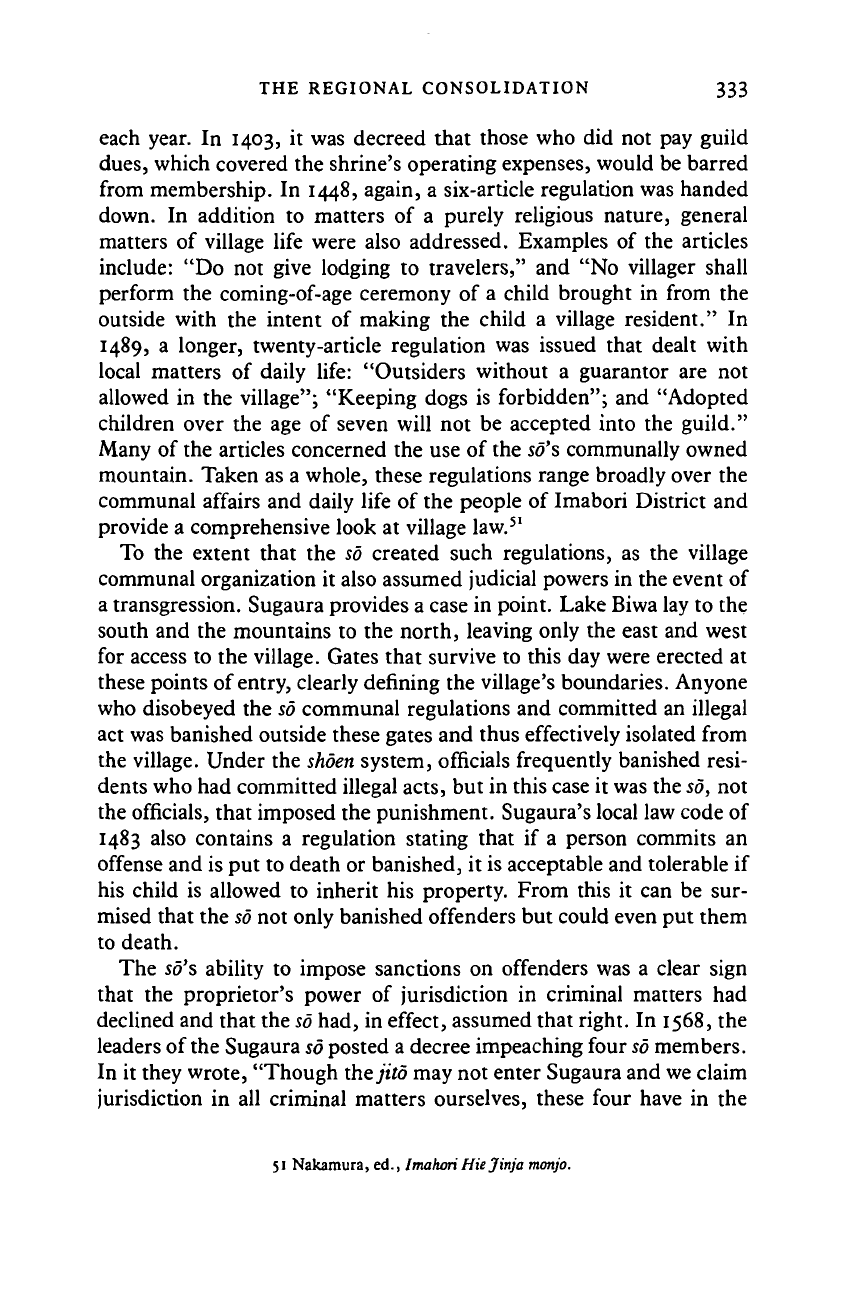
THE REGIONAL CONSOLIDATION 333
each year. In 1403, it was decreed that those who did not pay guild
dues,
which covered the shrine's operating expenses, would be barred
from membership. In 1448, again, a six-article regulation was handed
down. In addition to matters of a purely religious nature, general
matters of village life were also addressed. Examples of the articles
include: "Do not give lodging to travelers," and "No villager shall
perform the coming-of-age ceremony of a child brought in from the
outside with the intent of making the child a village resident." In
1489,
a longer, twenty-article regulation was issued that dealt with
local matters of daily life: "Outsiders without a guarantor are not
allowed in the village"; "Keeping dogs is forbidden"; and "Adopted
children over the age of seven will not be accepted into the guild."
Many of the articles concerned the use of the so's communally owned
mountain. Taken as a whole, these regulations range broadly over the
communal affairs and daily life of the people of Imabori District and
provide a comprehensive look at village law.
51
To the extent that the 50 created such regulations, as the village
communal organization it also assumed judicial powers in the event of
a transgression. Sugaura provides a case in point. Lake Biwa lay to the
south and the mountains to the north, leaving only the east and west
for access to the village. Gates that survive to this day were erected at
these points of entry, clearly defining the village's boundaries. Anyone
who disobeyed the so communal regulations and committed an illegal
act was banished outside these gates and thus effectively isolated from
the village. Under the
shoen
system, officials frequently banished resi-
dents who had committed illegal acts, but in this case it was the
so,
not
the officials, that imposed the punishment. Sugaura's local law code of
1483 also contains a regulation stating that if a person commits an
offense and is put to death or banished, it is acceptable and tolerable if
his child is allowed to inherit his property. From this it can be sur-
mised that the
so
not only banished offenders but could even put them
to death.
The so's ability to impose sanctions on offenders was a clear sign
that the proprietor's power of jurisdiction in criminal matters had
declined and that the so had, in effect, assumed that right. In 1568, the
leaders of the Sugaura
so
posted a decree impeaching four
so
members.
In it they wrote, "Though the jitd may not enter Sugaura and we claim
jurisdiction in all criminal matters ourselves, these four have in the
51 Nakamura, ed., Imahori Hiejinja monjo.
Cambridge Histories Online © Cambridge University Press, 2008
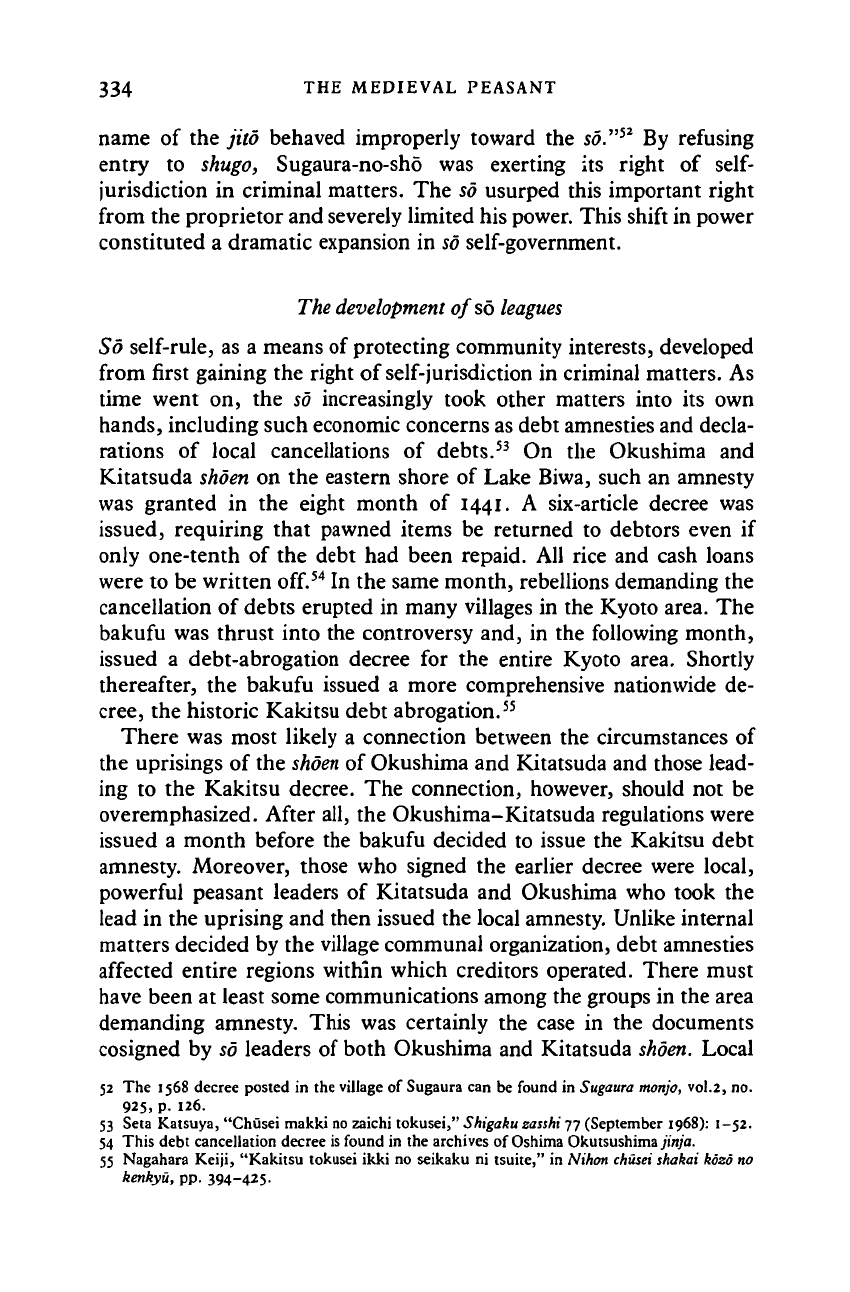
334
THE
MEDIEVAL PEASANT
name
of the
jito behaved improperly toward
the
so."
52
By
refusing
entry
to
shugo, Sugaura-no-sho
was
exerting
its
right
of self-
jurisdiction
in
criminal matters.
The
so usurped this important right
from the proprietor and severely limited his power. This shift in power
constituted
a
dramatic expansion
in
so self-government.
The development of so
leagues
So self-rule,
as a
means
of
protecting community interests, developed
from first gaining
the
right
of
self-jurisdiction
in
criminal matters.
As
time went
on, the so
increasingly took other matters into
its own
hands,
including such economic concerns as debt amnesties and decla-
rations
of
local cancellations
of
debts.
53
On the
Okushima
and
Kitatsuda
shoen
on the
eastern shore
of
Lake Biwa, such
an
amnesty
was granted
in the
eight month
of
1441.
A
six-article decree
was
issued, requiring that pawned items
be
returned
to
debtors even
if
only one-tenth
of the
debt
had
been repaid.
All
rice
and
cash loans
were
to be
written
off.
54
In the
same month, rebellions demanding
the
cancellation
of
debts erupted
in
many villages
in the
Kyoto area.
The
bakufu
was
thrust into
the
controversy
and, in the
following month,
issued
a
debt-abrogation decree
for the
entire Kyoto area. Shortly
thereafter,
the
bakufu issued
a
more comprehensive nationwide
de-
cree,
the
historic Kakitsu debt abrogation.
55
There
was
most likely
a
connection between
the
circumstances
of
the uprisings
of
the
shoen
of
Okushima
and
Kitatsuda
and
those lead-
ing
to the
Kakitsu decree.
The
connection, however, should
not be
overemphasized. After all,
the
Okushima-Kitatsuda regulations were
issued
a
month before
the
bakufu decided
to
issue
the
Kakitsu debt
amnesty. Moreover, those
who
signed
the
earlier decree were local,
powerful peasant leaders
of
Kitatsuda
and
Okushima
who
took
the
lead
in the
uprising
and
then issued
the
local amnesty. Unlike internal
matters decided
by the
village communal organization, debt amnesties
affected entire regions within which creditors operated. There must
have been
at
least some communications among the groups
in the
area
demanding amnesty. This
was
certainly
the
case
in the
documents
cosigned
by
so
leaders
of
both Okushima
and
Kitatsuda
shoen.
Local
52
The 1568
decree posted
in the
village
of
Sugaura
can be
found
in
Sugaura
monjo,
vol.2,
no.
925,
p. 126.
53 Seta Katsuya, "Chusei makki no zaichi tokusei," Shigaku zasshi 77 (September 1968):
1-52.
54 This debt cancellation decree is found
in the
archives
of
Oshima Okutsushima jinja.
55 Nagahara Keiji, "Kakitsu tokusei ikki
no
seikaku
ni
tsuite,"
in
Nihon
chusei
shakai kozo
no
kenkyu,
pp.
394-425-
Cambridge Histories Online © Cambridge University Press, 2008
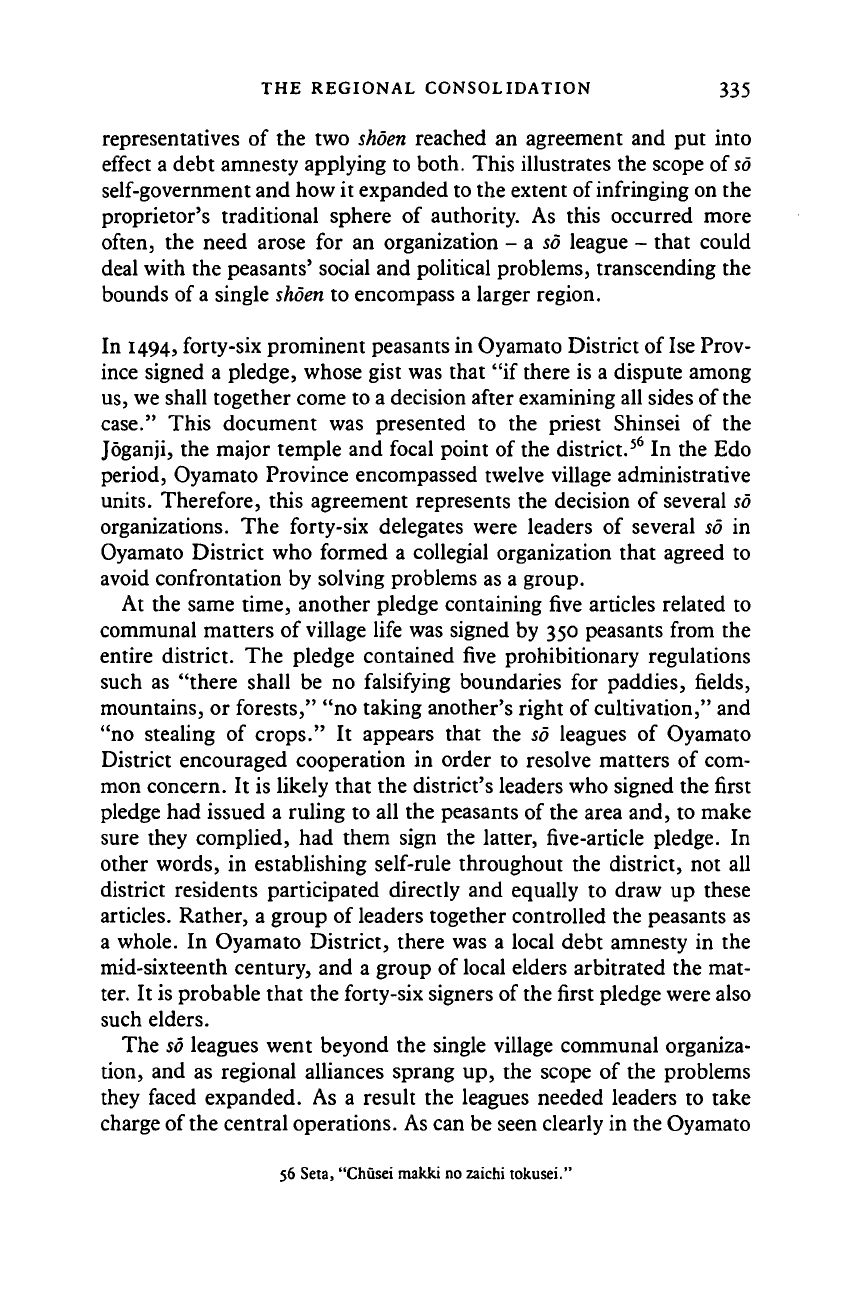
THE REGIONAL CONSOLIDATION 335
representatives of the two shoen reached an agreement and put into
effect a debt amnesty applying to both. This illustrates the scope of so
self-government and how it expanded to the extent of infringing on the
proprietor's traditional sphere of authority. As this occurred more
often, the need arose for an organization - a so league - that could
deal with the peasants' social and political problems, transcending the
bounds of a single shoen to encompass a larger region.
In 1494, forty-six prominent peasants in Oyamato District of Ise Prov-
ince signed a pledge, whose gist was that "if there is a dispute among
us,
we shall together come to a decision after examining all sides of the
case."
This document was presented to the priest Shinsei of the
Joganji, the major temple and focal point of the district.
56
In the Edo
period, Oyamato Province encompassed twelve village administrative
units.
Therefore, this agreement represents the decision of several sd
organizations. The forty-six delegates were leaders of several so in
Oyamato District who formed a collegial organization that agreed to
avoid confrontation by solving problems as a group.
At the same time, another pledge containing five articles related to
communal matters of village life was signed by 350 peasants from the
entire district. The pledge contained five prohibitionary regulations
such as "there shall be no falsifying boundaries for paddies, fields,
mountains, or forests," "no taking another's right of cultivation," and
"no stealing of crops." It appears that the so leagues of Oyamato
District encouraged cooperation in order to resolve matters of com-
mon concern. It is likely that the district's leaders who signed the first
pledge had issued a ruling to all the peasants of the area and, to make
sure they complied, had them sign the latter, five-article pledge. In
other words, in establishing self-rule throughout the district, not all
district residents participated directly and equally to draw up these
articles. Rather, a group of leaders together controlled the peasants as
a whole. In Oyamato District, there was a local debt amnesty in the
mid-sixteenth century, and a group of local elders arbitrated the mat-
ter. It is probable that the forty-six signers of the first pledge were also
such elders.
The so leagues went beyond the single village communal organiza-
tion, and as regional alliances sprang up, the scope of the problems
they faced expanded. As a result the leagues needed leaders to take
charge of the central operations. As can be seen clearly in the Oyamato
56 Seta, "Chusei makki no zaichi tokusei."
Cambridge Histories Online © Cambridge University Press, 2008
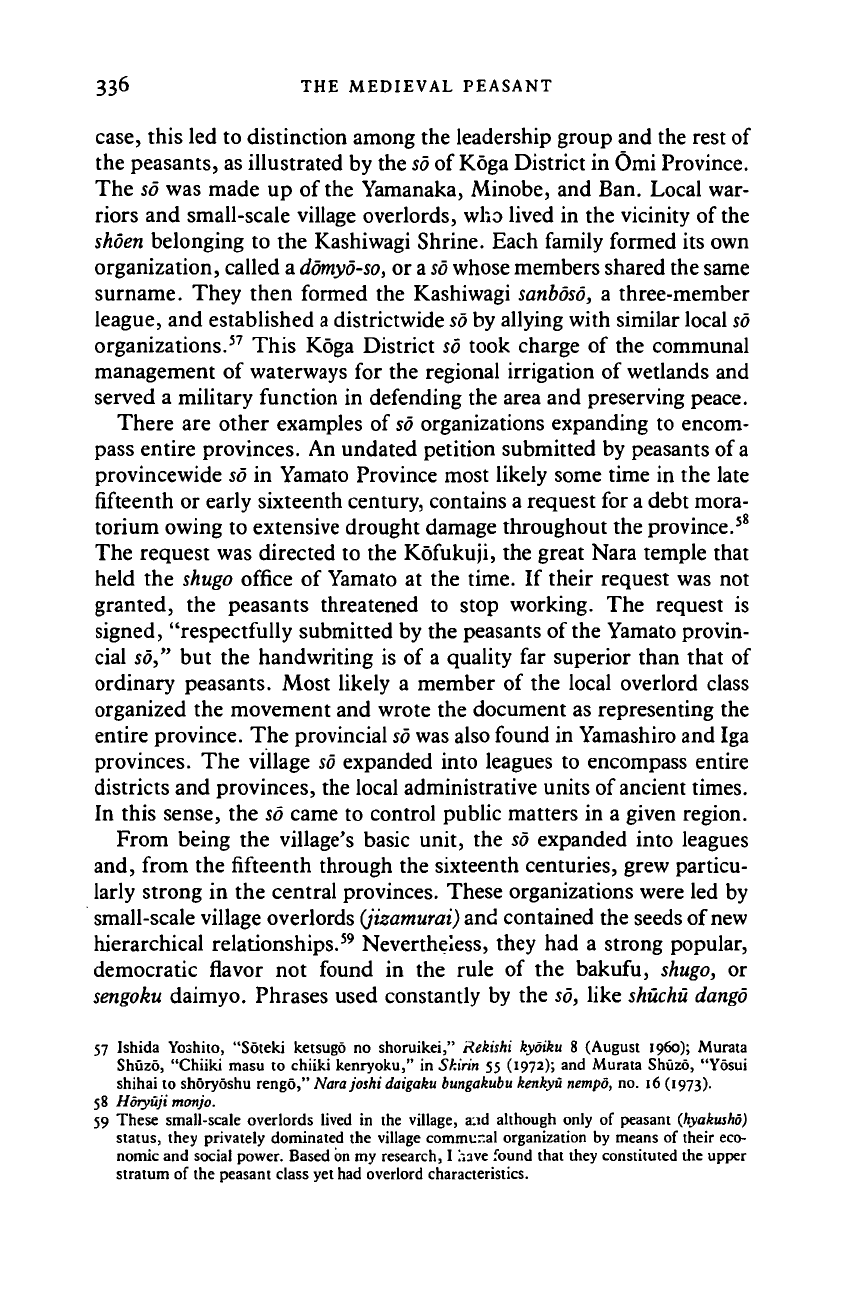
336 THE MEDIEVAL PEASANT
case,
this led to distinction among the leadership group and the rest of
the peasants, as illustrated by the
so
of Koga District in Omi Province.
The so was made up of the Yamanaka, Minobe, and Ban. Local war-
riors and small-scale village overlords, who lived in the vicinity of the
shoen belonging to the Kashiwagi Shrine. Each family formed its own
organization, called a
domyo-so,
or a
so
whose members shared the same
surname. They then formed the Kashiwagi sanboso, a three-member
league, and established a districtwide
so
by allying with similar local so
organizations.
57
This Koga District so took charge of the communal
management of waterways for the regional irrigation of wetlands and
served a military function in defending the area and preserving peace.
There are other examples of so organizations expanding to encom-
pass entire provinces. An undated petition submitted by peasants of a
provincewide so in Yamato Province most likely some time in the late
fifteenth or early sixteenth century, contains a request for a debt mora-
torium owing to extensive drought damage throughout the province.
58
The request was directed to the Kofukuji, the great Nara temple that
held the shugo office of Yamato at the time. If their request was not
granted, the peasants threatened to stop working. The request is
signed, "respectfully submitted by the peasants of the Yamato provin-
cial so," but the handwriting is of a quality far superior than that of
ordinary peasants. Most likely a member of the local overlord class
organized the movement and wrote the document as representing the
entire province. The provincial
so
was also found in Yamashiro and Iga
provinces. The village so expanded into leagues to encompass entire
districts and provinces, the local administrative units of ancient times.
In this sense, the so came to control public matters in a given region.
From being the village's basic unit, the so expanded into leagues
and, from the fifteenth through the sixteenth centuries, grew particu-
larly strong in the central provinces. These organizations were led by
small-scale village overlords (jizamurai) and contained the seeds of new
hierarchical relationships.
59
Nevertheless, they had a strong popular,
democratic flavor not found in the rule of the bakufu, shugo, or
sengoku daimyo. Phrases used constantly by the so, like shuchu dango
57
Ishida Yoshito, "Soteki ketsugo no shoruikei," Rekishi kyoiku 8 (August
i960);
Murata
Shuzo,
"Chiiki masu to chiiki kenryoku," in
Sh.irin
55 (1972); and Murata Shuzo, "Yosui
shihai
to shoryoshu rengo," Narajoshi
daigaku bungakubu kenkyu
nempo,
no. 16 (1973).
58
Hdryuji monjo.
59
These small-scale overlords lived in the village, and although only of peasant (hyakusho)
status,
they privately dominated the village communal organization by means of their eco-
nomic
and social power. Based on my research, I have found that they constituted the upper
stratum
of the peasant class yet had overlord characteristics.
Cambridge Histories Online © Cambridge University Press, 2008
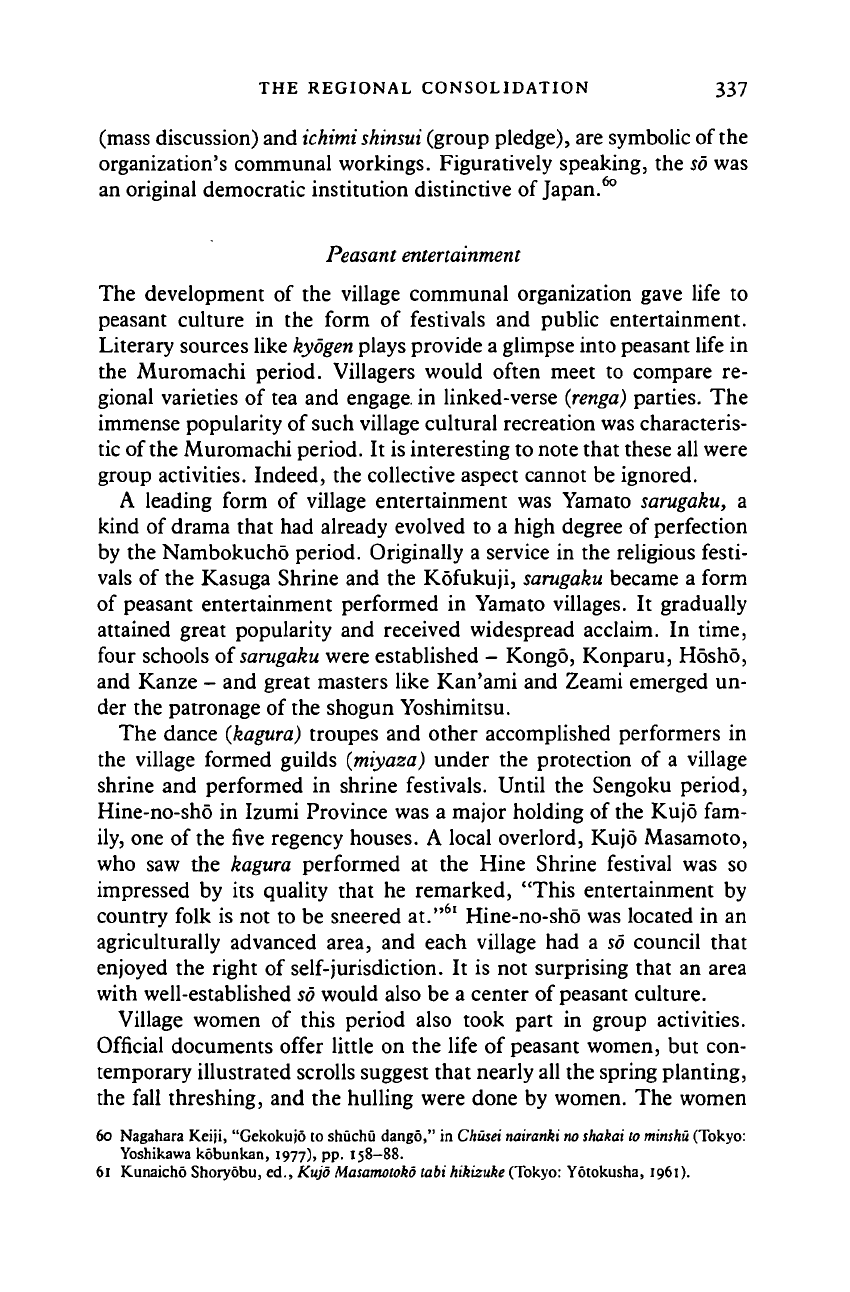
THE REGIONAL CONSOLIDATION 337
(mass discussion) and ichimi
shinsui
(group pledge), are symbolic of the
organization's communal workings. Figuratively speaking, the so was
an original democratic institution distinctive of Japan.
60
Peasant
entertainment
The development of the village communal organization gave life to
peasant culture in the form of festivals and public entertainment.
Literary sources like kyogen plays provide a glimpse into peasant life in
the Muromachi period. Villagers would often meet to compare re-
gional varieties of tea and engage, in linked-verse
(renga)
parties. The
immense popularity of such village cultural recreation was characteris-
tic of the Muromachi period. It is interesting to note that these all were
group activities. Indeed, the collective aspect cannot be ignored.
A leading form of village entertainment was Yamato sarugaku, a
kind of drama that had already evolved to a high degree of perfection
by the Nambokuchd period. Originally a service in the religious festi-
vals of the Kasuga Shrine and the Kofukuji, sarugaku became a form
of peasant entertainment performed in Yamato villages. It gradually
attained great popularity and received widespread acclaim. In time,
four schools of
sarugaku
were established - Kongo, Konparu, Hosho,
and Kanze - and great masters like Kan'ami and Zeami emerged un-
der the patronage of the shogun Yoshimitsu.
The dance {kagura) troupes and other accomplished performers in
the village formed guilds (miyaza) under the protection of a village
shrine and performed in shrine festivals. Until the Sengoku period,
Hine-no-sho in Izumi Province was a major holding of the Kujo fam-
ily, one of the five regency houses. A local overlord, Kujo Masamoto,
who saw the kagura performed at the Hine Shrine festival was so
impressed by its quality that he remarked, "This entertainment by
country folk is not to be sneered at."
61
Hine-no-sho was located in an
agriculturally advanced area, and each village had a so council that
enjoyed the right of self-jurisdiction. It is not surprising that an area
with well-established so would also be a center of peasant culture.
Village women of this period also took part in group activities.
Official documents offer little on the life of peasant women, but con-
temporary illustrated scrolls suggest that nearly all the spring planting,
the fall threshing, and the hulling were done by women. The women
60 Nagahara Keiji, "Gekokujo to shuchu dango," in Chusei nairanki no shakai to minshu (Tokyo:
Yoshikawa kobunkan, 1977), pp. 158-88.
61 Kunaicho Shoryobu, ed., Kujo Masamotoko tabi hikizuke (Tokyo: Yotokusha, 1961).
Cambridge Histories Online © Cambridge University Press, 2008
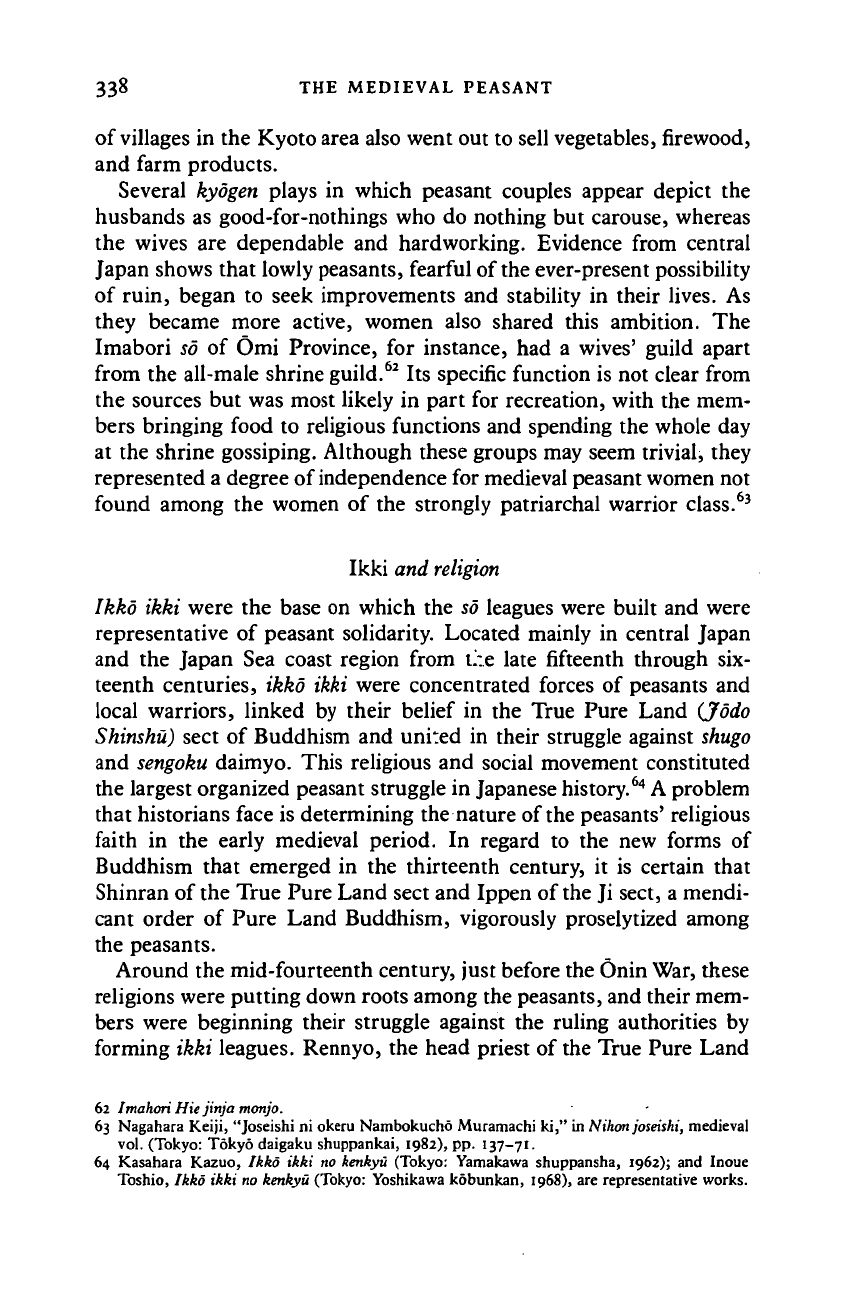
338 THE MEDIEVAL PEASANT
of
villages
in the Kyoto area also went out to sell vegetables, firewood,
and farm products.
Several kyogen plays in which peasant couples appear depict the
husbands as good-for-nothings who do nothing but carouse, whereas
the wives are dependable and hardworking. Evidence from central
Japan shows that lowly peasants, fearful of the ever-present possibility
of ruin, began to seek improvements and stability in their lives. As
they became more active, women also shared this ambition. The
Imabori so of Omi Province, for instance, had a wives' guild apart
from the all-male shrine guild.
62
Its specific function is not clear from
the sources but was most likely in part for recreation, with the mem-
bers bringing food to religious functions and spending the whole day
at the shrine gossiping. Although these groups may seem trivial, they
represented a degree of independence for medieval peasant women not
found among the women of the strongly patriarchal warrior class.
63
Ikki and
religion
Ikko ikki were the base on which the so leagues were built and were
representative of peasant solidarity. Located mainly in central Japan
and the Japan Sea coast region from L:e late fifteenth through six-
teenth centuries, ikko ikki were concentrated forces of peasants and
local warriors, linked by their belief in the True Pure Land (Jodo
Shinshu) sect of Buddhism and united in their struggle against
shugo
and
sengoku
daimyo. This religious and social movement constituted
the largest organized peasant struggle in Japanese history.
64
A
problem
that historians face is determining the nature of
the
peasants' religious
faith in the early medieval period. In regard to the new forms of
Buddhism that emerged in the thirteenth century, it is certain that
Shinran of the True Pure Land sect and Ippen of the Ji sect, a mendi-
cant order of Pure Land Buddhism, vigorously proselytized among
the peasants.
Around the mid-fourteenth century, just before the Onin War, these
religions were putting down roots among the peasants, and their mem-
bers were beginning their struggle against the ruling authorities by
forming ikki leagues. Rennyo, the head priest of the True Pure Land
62 Imahori Hie jinja monjo.
63 Nagahara Keiji, "Joseishi ni okeru Nambokucho Muramachi ki," in
Nihon
joseishi,
medieval
vol. (Tokyo: Tokyo daigaku shuppankai, 1982), pp. 137-71.
64 Kasahara Kazuo, Ikko ikki no kenkyu (Tokyo: Yamakawa shuppansha, 1962); and Inoue
Toshio, Ikko ikki no kenkyu (Tokyo: Yoshikawa kobunkan, 1968), are representative works.
Cambridge Histories Online © Cambridge University Press, 2008
